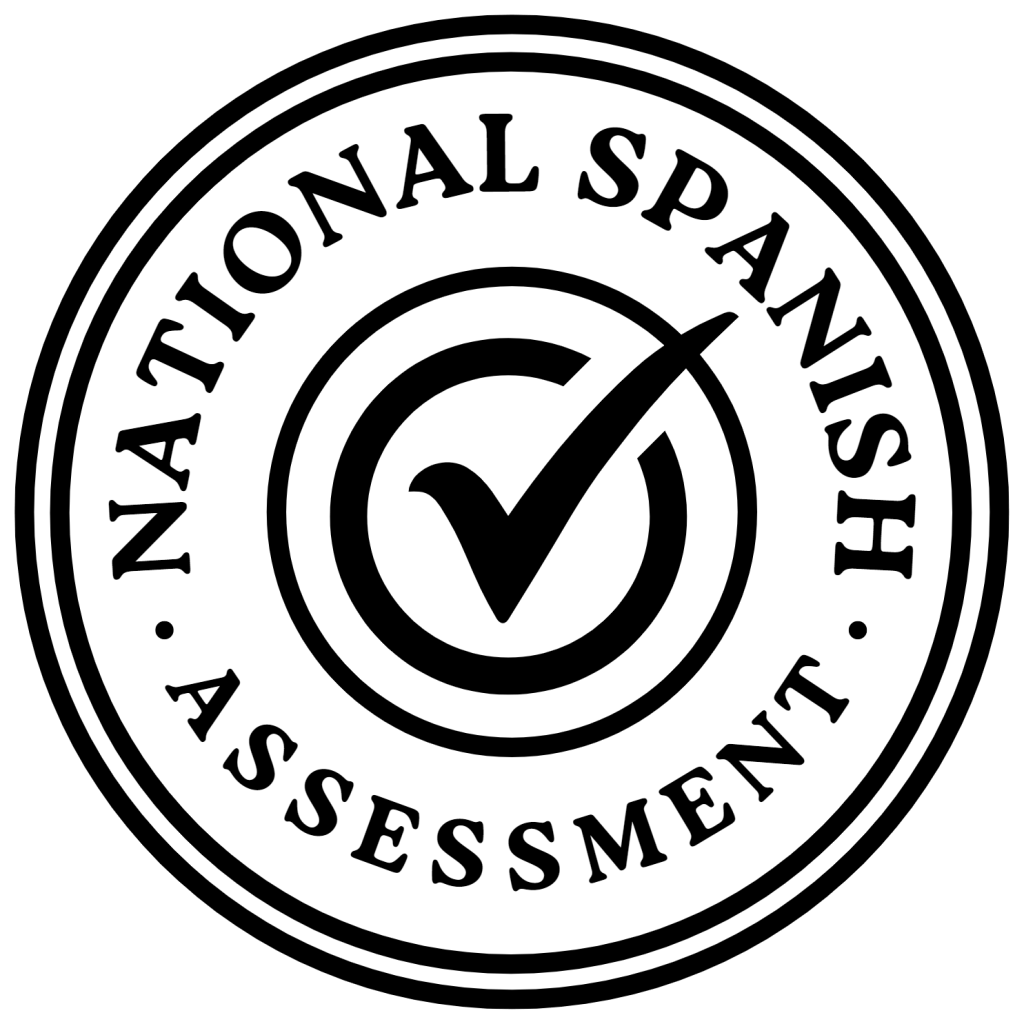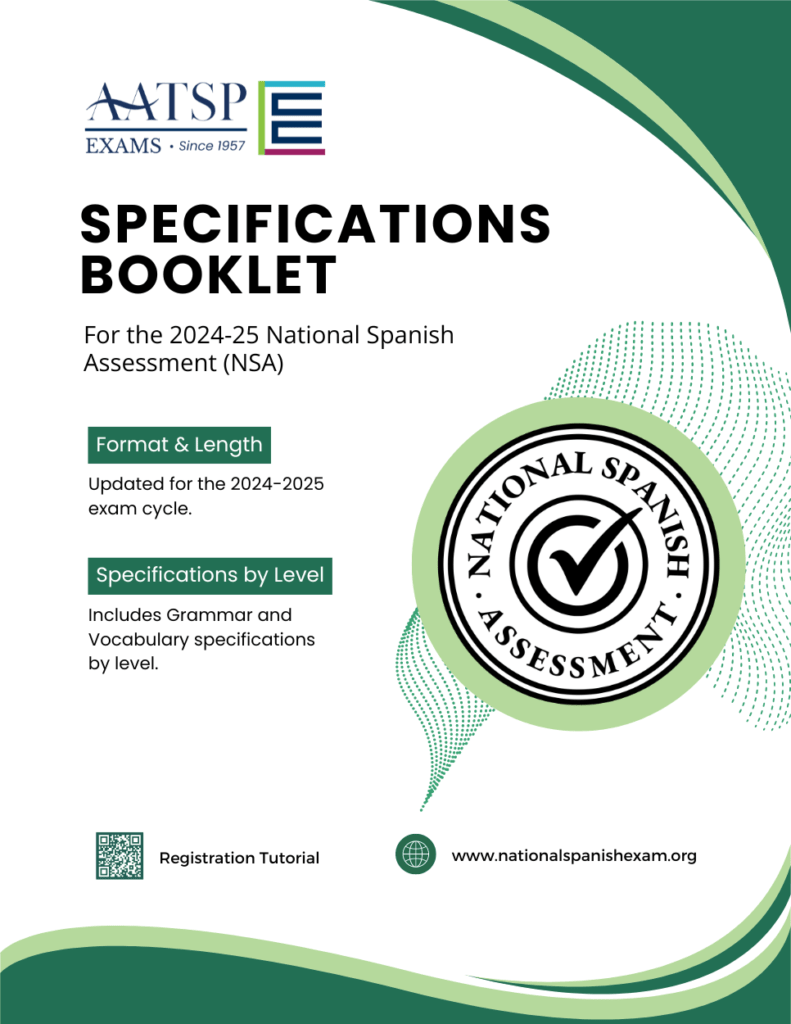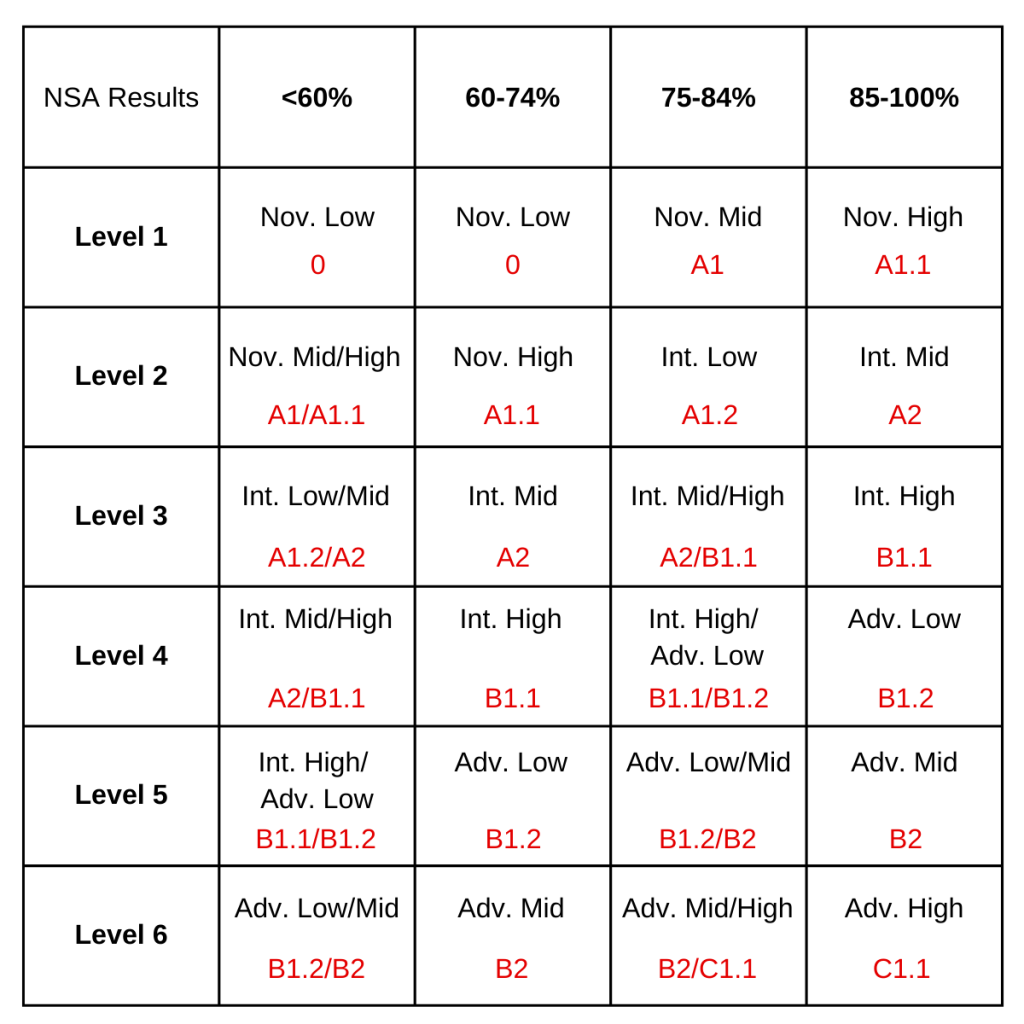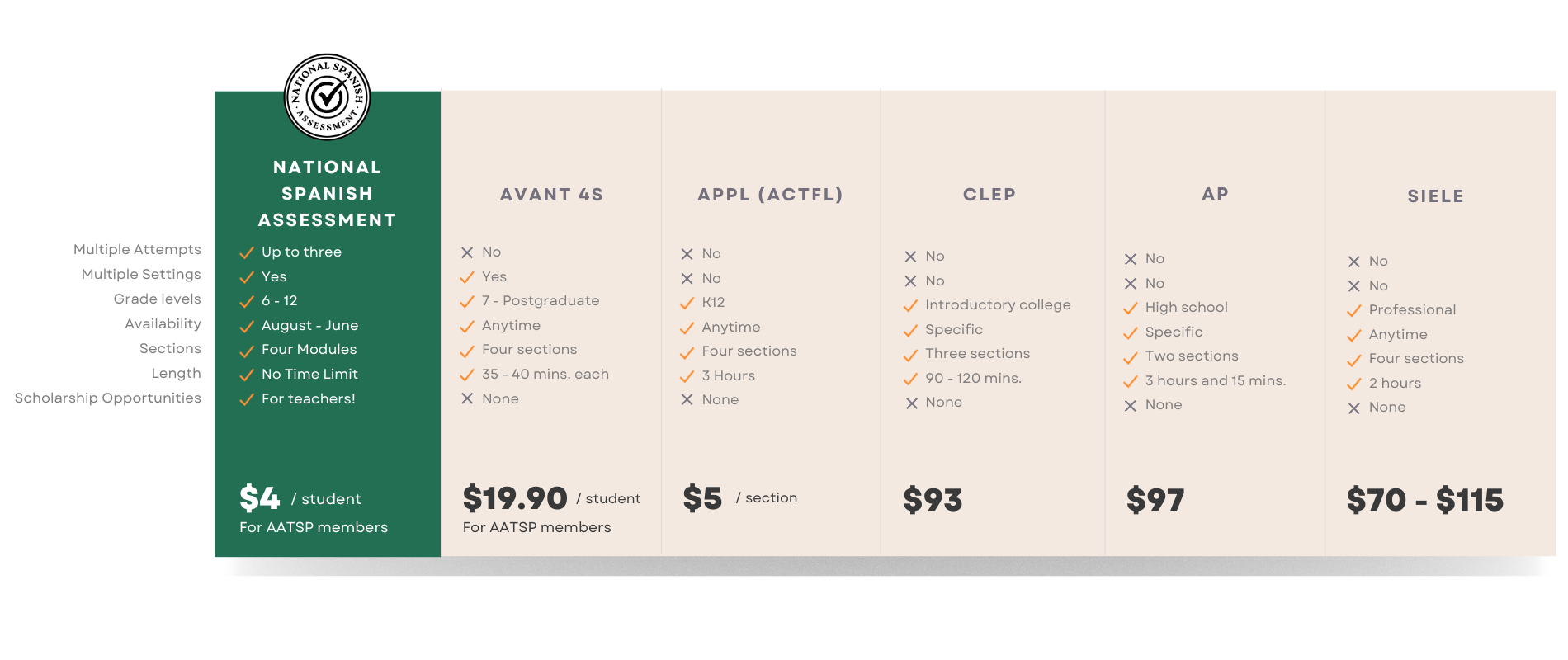NATIONAL SPANISH ASSESSMENT
Overview
The National Spanish Assessment (NSA) is a formative assessment tool that can be administered up to three times throughout the year to measure students’ progress and track their growth. It can be used as a diagnostic, placement, or benchmark test, and as a stepping stone to the National Spanish Exam (NSE), or other upper-level testing examinations.
The NSA is an online, standardized, computer-graded assessment that measures content (what a student knows) and performance standards (what a student can do). Additionally, the NSA provides detailed feedback that helps educators tailor instruction to meet individual student needs, and supports targeted learning strategies for improved language proficiency.
Each assessment attempt includes four modules that may also be administered separately: Vocabulary in Context, Grammar in Action, Reading/Interpretive Communication, Listening/Interpretive Communication.
Registration for the National Spanish Assessment (NSA) opens on August 15, 2024 and remains available until June 28, 2025.
What are the Advantages?
Join our very own AATSP Executive Director Maria Carreira in a short webinar on the advantages of the National Spanish Assessment (NSA) and its formative assessment value.

Overview
For: Middle – High School, College/University
Registration: August 15, 2024 – June 28, 2025
Results: Immediate
NOT A COMPETITION
Cost Information
There are two costs associated with administering the exam: student cost and instructor cost.
Student Cost
$4.00 per student
Teacher/Instructor Cost
Access to the NSA is a benefit for AATSP Members with an active membership.
- Active AATSP Members: FREE
- First-Year Membership: $45
- Membership Renewal: $65
- Non-Members: $75

TOP FEATURES
About the Assessment
HOW IT WORKS
Get to Know the Assessment
Content and Format
Modules
Why use the NSA?
How it Works
Results & Scoring
Prizes
Free Practice
Format & Length
The National Spanish Assessment (NSA) is a proficiency-based online exam designed to give teachers many different options and results for testing students, now available for Levels 01 – 6. Some of the content in the NSA mirrors material that can be found in past National Spanish Exams.
Specifications Booklet
Download the complete specifications e-book for the National Spanish Assessment (NSA), which includes the format and length chart, specifications for Grammar and Vocabulary, and additional resources for teachers.

Level Placement
For the National Spanish Assessment (NSA), level placement is at the instructor’s discretion. Students may take multiple levels if desired. Determining the appropriate assessment module to administer should be decided by the teacher and the student.
Please use the following chart as a guideline:
Please use the following chart as a guideline:
Level 01
Recommended for entry-level beginners The course content is equivalent to the first half of the Spanish 1 syllabus. (Novice low/mid ; <A1)
Level 1
Students whose course content is equivalent to the second-half of the Spanish 1 syllabus or entry-level for any program where the course content is equivalent to a full year of Spanish 1. (Novice mid/high; A1)
Level 2
Students whose course content is equivalent to the Spanish 2 syllabus. (Novice high/Int. Low; A1/A2)
Level 3
Students whose course content is equivalent to the Spanish 3 syllabus. (Intermediate low/mid; A2/B1)
Level 4
Students whose course content is equivalent to the Spanish 4 syllabus. (Intermediate mid/high; B1/B2)
Level 5
Students whose course content is equivalent to the Spanish 5 or AP Spanish syllabuses. (Intermediate high/Advanced low; B2)
Level 6
Students whose course content is equivalent to the Spanish 6 or AP Literature syllabuses. (Advanced low/mid/high; B2/C1)
AP Language / IB-SL Students
Students enrolled in a course labeled AP Language or IB-SL should be registered to take the current year’s NSE at one level higher than the course in which they were enrolled the previous year. For example, an AP Language/IB-SL student who sat for the exam at Level 4 in 2023-2024 should be placed in Level 5 in 2024-2025. Under no circumstance should an AP Language/IB-SL student take the NSE at lower than Level 4.
AP Literature / IB-HL Students
Students enrolled in a course labeled AP Literature or IB-HL must take the NSE at either Level 5 or 6. These students should be enrolled to take the current year’s NSE at one level higher than the course in which they were enrolled the previous year. Under no circumstance should an AP Literature/IB-HL student take the NSE at lower than Level 5.
Description of Modules
There are four modules per Level (est. 20 minutes each):
Grammar in Action
This module assesses content standards through the natural application of grammar in real-world communication settings. The learner’s mastery of language elements (grammar, vocabulary, syntax) directly supports the learner’s ability to communicate effectively at different proficiency levels. In this section, the learner will integrate linguistic competence into meaningful communication.
Vocabulary in Context
This module assesses content standards through the use of vocabulary in real-world communication contexts. The learner’s mastery of language elements (grammar, vocabulary, syntax) directly supports the learner’s ability to communicate effectively at different proficiency levels. In this section, the learner will integrate linguistic competence into meaningful communication.
Listening – Interpretive Communication
This module evaluates performance standards by assessing the learner’s ability to understand the spoken language, process information, and infer meaning within a real-life context. Listening comprehension and interpretive communication are essential indicators of language competency and proficiency.
Reading – Interpretive Communication
This module evaluates performance standards by assessing the learner’s ability to understand the written language, process information, and infer meaning within a real-life context. Reading comprehension and interpretive communication are essential indicators of language competency and proficiency.
About Modules
• The National Spanish Assessment (NSA) is divided into seven Levels (01 – 6).
• Each Level (01 – 6) includes four assessment modules (28 assessments in total).
• Each Module can be administered separately.
• Teachers may choose which module(s) they wish to administer to their students.
• Each Module can be administered up to three times at different points in the year to test for growth.
Purpose
The purpose of the National Spanish Assessments (NSA) is:
• To promote proficiency in interpretive, presentational and interpersonal communication
• To assess the national standards as they pertain to learning Spanish
• To measure student growth during the learning process
• To provide several options for testing different skills
Advantages of the NSA
The NSA is the most flexible testing program offered in our suite of exams. Take a look at the following benefits of the NSA:
• The National Spanish Assessment (NSA) provides immediate results
• It may be administered up to three (3) times a year to show growth during the academic year
• It may be used to determine college-level proficiency ratings
• Four modules are available for teachers to administer: Reading, Grammar, Vocabulary, Listening
• Instructors may choose which of these modules they would like to administer
• Each module may be administered separately
• Levels 01-6 are available, and students are allowed to repeat Levels
• Not a national competition (ie. students are not eligible for prizes or scholarships)
• Teachers may be eligible to apply for teacher scholarships
• No late fees! Register at any time between August 15, 2024 – June 28, 2025
How It Works
Starting with a specific Level as a starting point, teachers complete their registration and invite their students to the National Spanish Assessment (NSA). Teachers have access to all of the NSA Levels, each of which include four modules, along with practice material related to the corresponding Level. Teachers have the option to test their students’ progress up to three times in the school year until the NSA window ends in late June.
Examples Of Use:
Take a look at some examples of how other teachers and school departments use the National Spanish Assessment:
• Growth Tracking: You decide to use only one, or two, or three, or all four of the National Spanish Assessment’s flexible modules to evaluate your students’ progress throughout the school year (year-start, mid-year, end-of-year).
• Placement: You believe that a new student will fare well in Level 2. You decide to use the first attempt to evaluate the student’s proficiency at Level 2 (placement), and then use the remaining two attempts to track the student’s growth at different levels.
• Preparation: You enter your students in the National Spanish Exam (NSE) every year. You utilize the NSA to test for placement and prepare your students for the national competition.
• Formative Value: You use the NSA in the classroom as a teaching activity, combined with a KWL chart to engage students in their own learning process.
• Independent teachers: You teach Spanish at a learning center or independently. You use the NSA to track your students’ growth and provide parents with valuable data.
• Strategic Planning: You use the National Spanish Assessment (NSA) for benchmarking, operationalizing objectives, and monitoring outcomes and successes over time.
• Summer School: You enroll your students in the National Spanish Assessment as part of your Summer School program.
• College Placement: You are a Spanish professor at the undergraduate level and use the NSA as a placement and growth tracking tool for new or first-year students.
• …and more! The National Spanish Assessment (NSA) is flexible and modular by design so that instructors can use it to suit their needs.
Scoring
Teachers have access to raw scores and percentages once results are available.
Results
Results are available immediately. In order to have a more complete picture of the student’s language capacity, please take each student’s individual background and exposure to the language into account when utilizing the scale below. This scale is intended to provide teachers with a basis for interpretation of their student’s results using the rating guidelines from the CEFR (Common European Framework of Reference) and ACTFL (the American Council on the Teaching of Foreign Languages).

* Note: These levels do NOT necessarily correspond to course levels but rather to proficiency levels. (i.e. Level 3 ≠ Spanish III)
Certificates
Students who take the National Spanish Assessment (NSA) may be given an optional certificate of completion. Because the NSA is not a competition, students are not eligible for medals or student scholarships. Instructors who administer the NSA may be eligible to apply for a teacher scholarship.
Free Practice
Complimentary practice modules are available on the FREE PREP. To access these materials, please click on the button below.
OPTIONS BEYOND THE CLASSROOM
A Resource for Spanish Teachers
Teachers state that they use the National Spanish Assessment (NSA) to “Prepare students to take other standardized tests such as AP, IB, SAT II and college placement exams.” Administrators state that they can use data from the National Spanish Assessment to “Create reports to show how their schools have improved over an academic year.”
While the NSA is usually implemented in schools by middle-to-high school Spanish teachers, it is also used at the community college, university, and even professional level for placement and benchmarking. Take a look at how the NSA compares to other exams*:

*Note for clarification: The cost of Avant 4S for AATSP Members applies after a minimum purchase of 10 tests.
Register Today
Are you ready to sign up for the National Spanish Assessment (NSA)? Registration for the 2024-25 school year will be available from August 15, 2024 until June 28, 2025.

